The Villa Romana del Casale, located in Piazza Armerina, Sicily, is home to one of the most extraordinary and well-preserved mosaics from the ancient Roman world. The Mosaic of the Great Hunt, found in the villa’s Room of the Great Hunt, provides a stunning glimpse into Roman life, art, and culture. It is not only a marvel of artistic achievement but also an important historical artifact that offers insights into Roman society, hunting practices, and their connection to nature. Follow archeology.dulichvn.net to discover many hidden mysteries that have yet to be discovered.
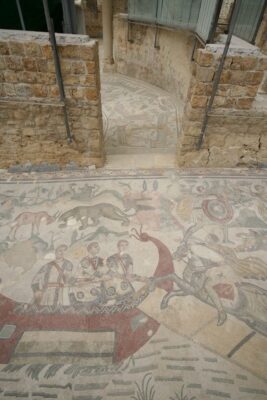
Origins and Discovery of the Mosaic
The Villa Romana del Casale: A Roman Luxury Residence
The Villa Romana del Casale was built during the 4th century CE, likely under the ownership of a wealthy Roman elite family. The villa’s grand design, sprawling layout, and extensive mosaic floors reflect the status and opulence of its inhabitants. Situated in the countryside near Piazza Armerina, the villa was both a luxurious residence and a symbol of Roman affluence and taste.
Discovery and Excavation
The mosaic was uncovered in 1950 during excavations at the Villa Romana del Casale. Since then, the villa and its mosaics have become a major archaeological site in Sicily. The complex features some of the most complete and intricate mosaics in the world, with the Great Hunt mosaic being one of its finest and most famous works.
The Importance of the Mosaic
The Mosaic of the Great Hunt is often considered one of the most impressive and well-preserved examples of Roman floor mosaics. With its vivid colors, realistic depictions, and sheer scale, it provides an invaluable window into Roman art and the culture of the time. The mosaic is a key element that helps the Villa Romana del Casale stand out as a UNESCO World Heritage site.
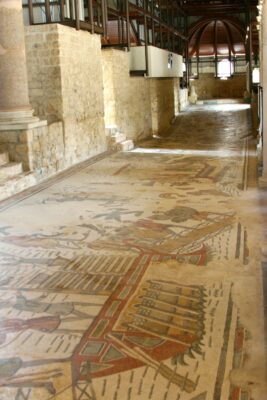
Artistic Features of the Mosaic
Depictions of the Great Hunt
The Mosaic of the Great Hunt spans the floor of one of the villa’s main rooms. The artwork vividly depicts a royal hunting scene, showcasing various wild animals, including lions, leopards, and gazelles, as well as hunters and dogs. These scenes capture the grandeur of Roman hunting expeditions, where wealthy elites would hunt exotic animals as a display of their power and prestige.
Intricate Detail and Craftsmanship
The mosaic is crafted with remarkable attention to detail. The use of tiny, colored tiles (called tesserae) allows for the creation of highly detailed and dynamic scenes. The artists demonstrated exceptional skill in capturing motion and expressions, particularly in the animals’ features and the hunt’s action. The mosaic’s depth and complexity make it a masterpiece of ancient Roman art.
Symbolism and Meaning
While the mosaic primarily portrays the theme of hunting, it is also rich in symbolic meaning. The act of hunting was often associated with Roman nobility, demonstrating power, dominance over nature, and the ability to conquer wild beasts. The hunt could also symbolize Roman virtues like courage and skill, further elevating the status of the villa’s owner.
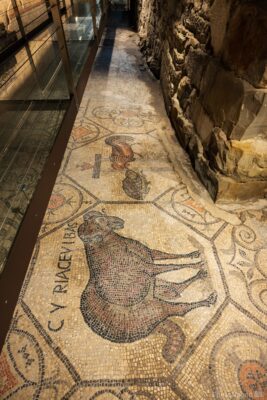
The Historical and Cultural Significance
A Window into Roman Society
The Mosaic of the Great Hunt offers more than just a visual spectacle; it serves as a snapshot of Roman social life. The scene represents not only a hunting activity but also a celebration of elite culture in ancient Rome. It emphasizes the importance of public displays of wealth, status, and power through activities such as hunting, which was reserved for the upper classes.
The Role of Hunting in Roman Culture
Hunting was a favored pastime of the Roman elite, and it played a significant role in both social and political life. The mosaic’s depiction of the hunt illustrates how the practice was intertwined with the Roman nobility’s sense of identity and social standing. It also reflects their connection to nature, demonstrating both a literal and metaphorical dominance over the wild world.
A Reflection of Imperial Ideals
The Great Hunt mosaic can also be interpreted as a reflection of the imperial ideals of the Roman Empire. The scenes of conquest and triumph in the mosaic parallel the broader Roman pursuit of control, both militarily and culturally, over vast territories and people. It’s a reminder of the empire’s vast reach and the luxury that came with its dominance.
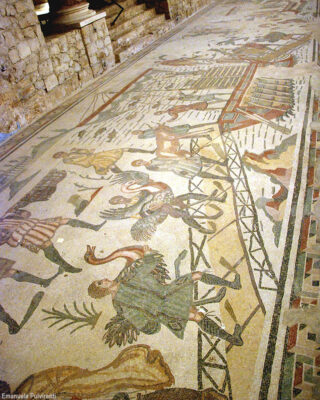
Preservation and Impact Today
Ongoing Preservation Efforts
Since its discovery, the Mosaic of the Great Hunt has undergone extensive preservation efforts to maintain its condition. The importance of the mosaic as part of the Villa Romana del Casale’s broader historical and cultural legacy has ensured that conservation work continues to protect the intricate details and vibrant colors of the artwork.
Recognition and UNESCO World Heritage Status
The Villa Romana del Casale, with its mosaics, including the Great Hunt, was inscribed as a UNESCO World Heritage Site in 1997. The site’s inclusion highlights the mosaic’s outstanding universal value, preserving the art and cultural heritage of ancient Rome for future generations.
Visitor Experience and Educational Impact
Today, the Villa Romana del Casale attracts visitors and scholars from around the world, who come to admire the mosaics and learn about Roman history. The Mosaic of the Great Hunt is a focal point for educational programs and exhibitions, helping people understand the artistic and cultural significance of ancient Rome.
See more: The Opening of the Eiffel Tower: A Landmark Moment in History
Conclusion: A Timeless Roman Masterpiece
The Mosaic of the Great Hunt at the Villa Romana del Casale in Piazza Armerina, Sicily, stands as one of the most stunning and historically significant examples of Roman art. Its vivid depictions of ancient hunting scenes, combined with its exceptional craftsmanship, offer a glimpse into the grandeur of Roman elite life and the culture that revered both nature and the power to control it. Today, the mosaic continues to captivate and educate visitors, ensuring its place as a timeless masterpiece in the history of art and architecture.

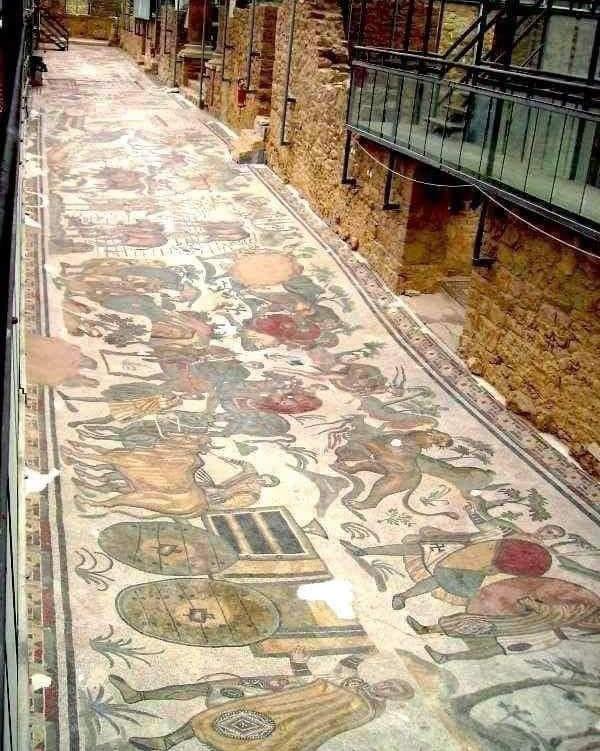
CÁC TIN KHÁC
Mary Walton: The Forgotten Inventor Who Helped Clean Up America’s Cities
Tomb of Queen Nefertari in the Valley of the Queens, Egypt
Discover the Hypostyle Hall of the Temple of Hathor at Dendera
Venus de Losange: Unveiling the Mystery of a 20,000-Year-Old Paleolithic Icon